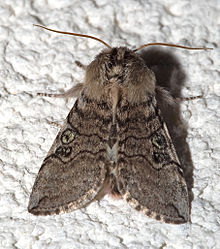- Drepanidae
-
- This article is about the moth family. For the sicklefishes, see Drepaneidae; for the Drepanidinae (or Drepanididae), see Hawaiian honeycreeper.
Drepanidae 
Achlya flavicornis Scientific classification Kingdom: Animalia Phylum: Arthropoda Class: Insecta Order: Lepidoptera (unranked): Macrolepidoptera Superfamily: Drepanoidea Family: Drepanidae
Meyrick, 1895Subfamilies The Drepanidae are a family of moths with about 1000[verification needed] species recorded worldwide. They are generally divided in three subfamilies (Minet and Scoble, 1999) which share the same type of hearing organ. Thyatirinae, previously often placed in their own family, bear a superficial resemblance to Noctuidae. Many species in the Drepanid family have a distinctively hook-shaped apex to the forewing, leading to their common name of hook-tips.
The larvae of many species are very distinctive, tapering to a point at the tail and usually resting with both head and tail raised. They usually feed on the leaves of trees and shrubs, pupating between leaves spun together with silk.
15 species are resident in the UK:
- Scalloped Hook-tip (Falcaria lacertinaria)
- Oak Hook-tip (Drepana binaria)
- Barred Hook-tip (Watsonalla cultraria)
- Pebble Hook-tip (Drepana falcataria)
- Scarce Hook-tip (Sabra harpagula)
- Chinese Character (Cilix glaucata)
- Peach Blossom (Thyatira batis)
- Buff Arches (Habrosyne pyritoides)
- Figure of Eighty (Tethea ocularis)
- Poplar Lutestring (Tethea or)
- Satin Lutestring (Tetheella fluctuosa)
- Common Lutestring (Ochropacha duplaris)
- Oak Lutestring (Cymatophorima diluta)
- Yellow Horned (Achlya flavicornis)
- Frosted Green (Polyploca ridens)
Species from India:
- Oreta extensa
References
- Chinery, Michael (1986): Collins Guide to the Insects of Britain and Western Europe
- Minet, J. & Scoble, M.J. (1999): The Drepanoid/Geometroid Assemblage. In: Kristensen, N.P. (ed.): Lepidoptera, Moths and Butterflies Volume 1: Evolution, Systematics, and Biogeography, chapter 17. Handbuch der Zoologie. Eine Naturgeschichte der Stämme des Tierreiches / Handbook of Zoology. A Natural History of the phyla of the Animal Kingdom. vol. IV: Arthropoda: Insecta. Part 35. Walter de Gruyter, Berlin & New York.
- Skinner, Bernard (1984): Colour Identification Guide to Moths of the British Isles
External links
- CSIRO Images

This article on a moth of the Drepanidae family is a stub. You can help Wikipedia by expanding it.
